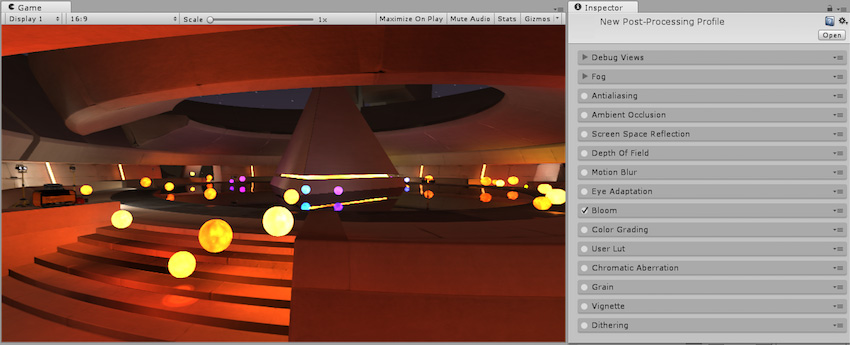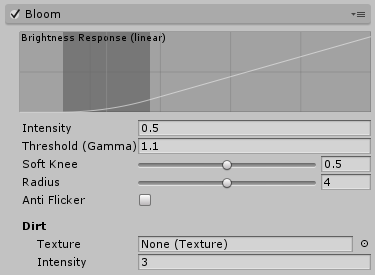Bloom
The effect descriptions on this page refer to the default effects found within the post-processing stack.
Bloom is an effect used to reproduce an imaging artifact of real-world cameras. The effect produces fringes of light extending from the borders of bright areas in an image, contributing to the illusion of an extremely bright light overwhelming the cameraA component which creates an image of a particular viewpoint in your scene. The output is either drawn to the screen or captured as a texture. More info
See in Glossary or eye capturing the sceneA Scene contains the environments and menus of your game. Think of each unique Scene file as a unique level. In each Scene, you place your environments, obstacles, and decorations, essentially designing and building your game in pieces. More info
See in Glossary.
In HDRhigh dymanic range
See in Glossary renderingThe process of drawing graphics to the screen (or to a render texture). By default, the main camera in Unity renders its view to the screen. More info
See in Glossary a Bloom effect should only affects areas of brightness above LDR range (above 1) by setting the Threshold parameter just above this value.



Properties
| Property: | Function: |
|---|---|
| Intensity | Strength of the Bloom filter. |
| Threshold | Filters out pixelsThe smallest unit in a computer image. Pixel size depends on your screen resolution. Pixel lighting is calculated at every screen pixel. More info See in Glossary under this level of brightness. |
| Soft Knee | Makes transition between under/over-threshold gradual (0 = hard threshold, 1 = soft threshold). |
| Radius | Changes extent of veiling effects in a screen resolution-independent fashion. |
| Anti Flicker | Reduces flashing noise with an additional filter. |
Optimisation
- Reduce Radius
Details
With properly exposed HDR scenes, Threshold should be set to ~1 so that only pixels with values above 1 leak into surrounding objects. You’ll probably want to drop this value when working in LDR or the effect won’t be visible.
Anti Flicker reduces flashing noise, commonly known as “fireflies”, by running an additional filter on the picture beforehand. This will affect performances and should be disabled when Temporal Anti-aliasing is enabled.
Lens Dirt
Lens DirtA Bloom effect property that applies a fullscreen layer of smudges or dust to diffract the Bloom effect. This is commonly used in modern first person shooters. More info
See in Glossary applies a fullscreen layer of smudges or dust to diffract the Bloom effect. This is commonly used in modern first person shootersA common game genre, featuring a first-person view of a 3D world, and gun-based combat with other players or NPCs.
See in Glossary.

Properties
| Property: | Function: |
|---|---|
| TextureAn image used when rendering a GameObject, Sprite, or UI element. Textures are often applied to the surface of a mesh to give it visual detail. More info See in Glossary |
Dirtiness texture to add smudges or dust to the lens. |
| Intensity | Amount of lens dirtiness |
Optimisation
- Reduce resolution of Lens Dirt texture
Details
Lens Dirt requires an input texture to use as a fullscreen layer. There are four Lens Dirt texture supplied in the Post-processing stack that should cover common use cases. These textures are supplied at 3840x2160 resolution for maximum quality and should be scaled dependent on project and platform. You can create custom Lens Dirt textures in any image editing software.
Requirements
- ShaderA small script that contains the mathematical calculations and algorithms for calculating the Color of each pixel rendered, based on the lighting input and the Material configuration. More info
See in Glossary model 3
See the Graphics Hardware Capabilities and Emulation page for further details and a list of compliant hardware.
2017–05–24 Page published with no editorial review
New feature in 5.6